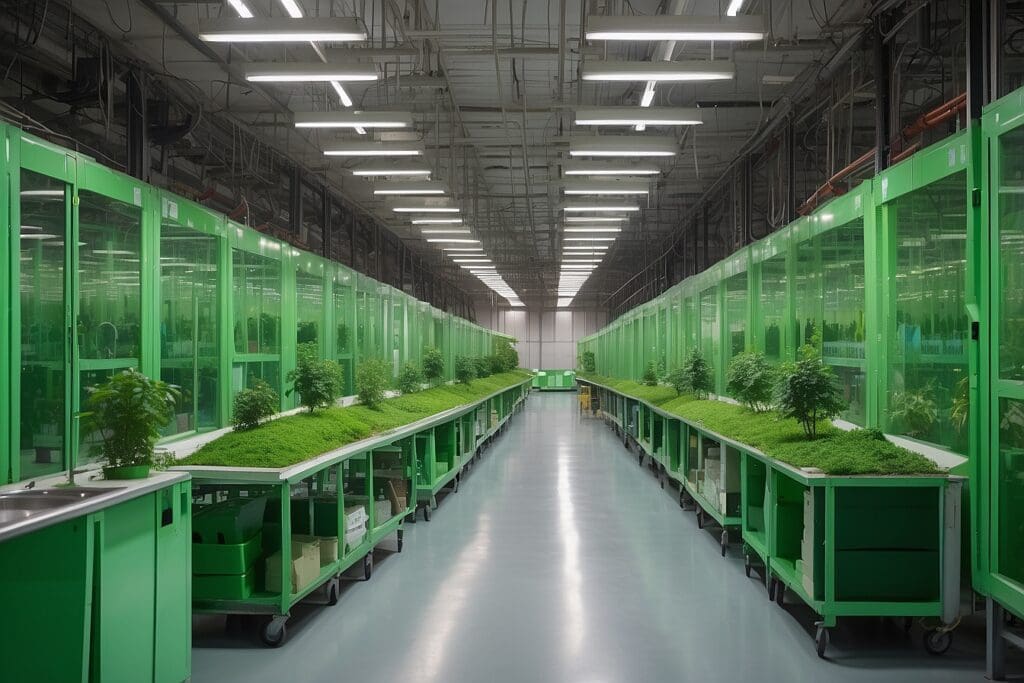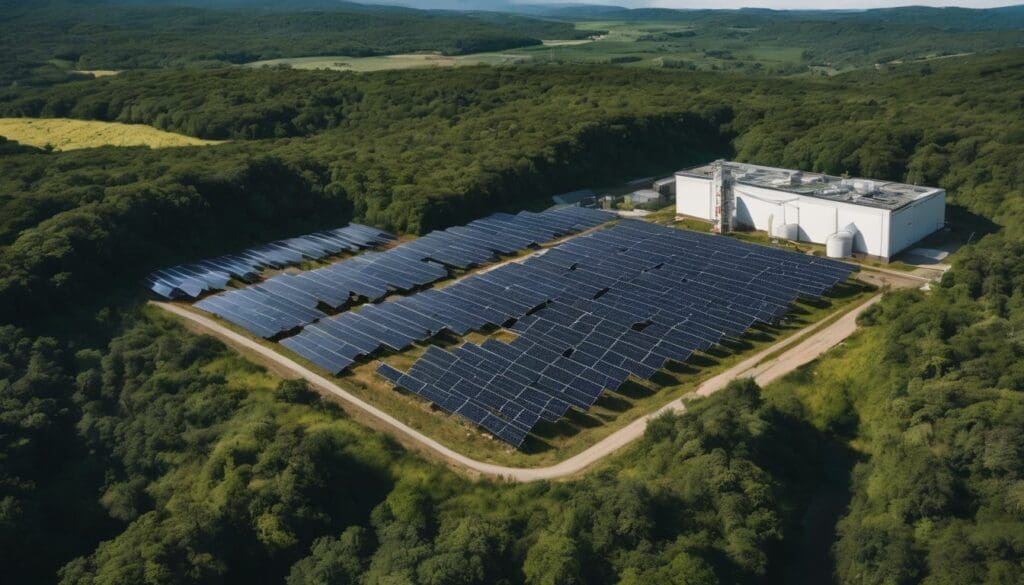Manufacturing impacts our planet, and many of us worry about its effects on the environment. Did you know that green manufacturing can significantly reduce waste and pollution? In this article, we’ll explore how embracing eco-friendly production methods presents both challenges and rewards for businesses.
Keep reading to find out more!
Key Takeaways
- Green manufacturing reduces waste and pollution by using energy – efficient processes and sustainable resources.
- It involves challenges such as ensuring environmental performance, adopting new technologies, and stakeholder engagement.
- Opportunities for businesses in green manufacturing include innovation, cost savings, meeting consumer demands, and strengthening brand image.
What is Green Manufacturing?
Green manufacturing marks a shift towards more responsible production. It tackles the environmental impact of creating goods by prioritising resource efficiency and waste reduction.
This approach to manufacturing integrates eco-friendly practices in every stage, from design to distribution. Companies focus on using renewable resources and energy-efficient processes to minimise their ecological footprint.
Adopting green technology forms the core of this sustainable movement, offering cleaner production methods that respect our planet’s health. Factories seek innovative systems that save water and reduce emissions while still maintaining market competitiveness.
More than just an operational change, green manufacturing embodies social responsibility where businesses become stewards of environmental stewardship, conscientiously balancing profit with planetary well-being.
Challenges of Green Manufacturing

Ensuring environmental performance and adopting green technologies are key challenges in green manufacturing. Engaging stakeholders and navigating market uncertainties also pose significant hurdles for eco-friendly production.
Ensuring environmental performance
To ensure environmental performance, manufacturers must prioritise sustainable resource management and green production methods. This involves optimising energy usage, minimising waste generation, and implementing eco-conscious processes across the supply chain.
Incorporating water conservation practices, reducing emissions, and adopting clean production technologies are essential for achieving environmentally sustainable manufacturing. Meeting social responsibility in production also entails engaging with stakeholders to promote transparent reporting on environmental impact and driving continuous improvement in sustainable manufacturing practices.
Striving for environmental performance demands ongoing commitment to eco-friendly production through operational changes that prioritise resource optimisation, cost-effective sustainability, and market competitiveness in sustainable manufacturing.
Adopting green technologies and practices
Green manufacturing involves the adoption of green technologies and practices to reduce environmental impact. Companies can implement energy-efficient processes, eco-friendly production methods, and sustainable production techniques.
Water conservation in manufacturing is also crucial for reducing overall environmental footprint.
To ensure cost-effective sustainability, businesses can invest in eco-conscious manufacturing and adopt environmentally friendly materials and production methods. This not only benefits the environment but also aligns with consumer demands for sustainable products and services while strengthening brand image within a competitive market.
Engaging stakeholders
Opportunities of Green Manufacturing
Embracing green manufacturing opens up opportunities for innovation in products and services, cost savings, meeting consumer demands, and strengthening brand image. Read on to learn more about the exciting possibilities of sustainable manufacturing.
Innovation in products and services
Green manufacturing offers a range of opportunities for innovation in products and services. Companies can develop eco-friendly production methods, energy-efficient processes, and cost-effective sustainability solutions.
By embracing these innovations, businesses can meet consumer demands for environmentally conscious manufacturing while also strengthening their brand image.
Innovation in products and services is crucial for maintaining a competitive edge in the market. Companies that invest in green technologies and practices not only contribute to environmental conservation but also position themselves as leaders in eco-conscious manufacturing.
Cost savings
Transitioning from innovation in products and services to cost savings, green manufacturing offers a significant opportunity for businesses to reduce operational expenses. By implementing energy-efficient processes and eco-friendly production methods, companies can lower their utility costs and minimise waste generation, leading to tangible financial savings.
The adoption of cost-effective sustainability measures not only benefits the environment but also contributes to the bottom line, demonstrating that eco-conscious manufacturing is not just good for the planet but also for profitability in the long run.
Furthermore, embracing eco-friendly manufacturing practices can lead to enhanced efficiency in resource utilisation, reducing raw material consumption and associated expenses. This approach not only aligns with environmental goals but also supports cost-effective sustainability while meeting consumer demands for environmentally friendly products at competitive prices.
Meeting consumer demands
Manufacturers are responding to the growing demand for eco-friendly products and services. Consumers increasingly seek sustainable options, prompting businesses to adapt their production processes and offerings.
This shift towards green manufacturing reflects an evolving market, with a focus on reducing environmental impact and meeting consumer expectations for environmentally responsible choices.
Businesses embracing green manufacturing practices can attract environmentally conscious consumers by providing products that align with their values. Meeting consumer demands for sustainable solutions offers a competitive edge in the marketplace, driving innovation and fostering brand loyalty among eco-conscious individuals seeking cost-effective sustainability options.
Strengthening brand image
Implementing green manufacturing practices can significantly enhance a company’s brand image. By demonstrating a commitment to eco-friendly production and energy-efficient processes, manufacturers can convey their dedication to sustainability.
This not only resonates with environmentally conscious consumers but also sets the stage for positive public perception and differentiation in the market.
Taking steps towards eco-conscious manufacturing helps in establishing a reputation as a socially responsible business, which is particularly appealing to modern consumers who prioritise environmental considerations.
Conclusion
In conclusion, green manufacturing presents numerous challenges and opportunities. Adapting to eco-friendly production methods can be complex but offers the potential for innovation and meeting consumer demands.
Implementing energy-efficient processes may initially require investment but can lead to cost savings in the long run. Engaging stakeholders is crucial for ensuring environmental performance, which in turn strengthens brand image and supports conservation efforts.
Eco-conscious manufacturing not only addresses challenges but also opens up avenues for sustainable growth and competitiveness in the market.
FAQs
1. What are the main challenges of green manufacturing?
Green manufacturing faces complexity in implementing energy-efficient processes and maintaining cost-effective sustainability while ensuring eco-friendly production standards.
2. How can businesses benefit from eco-friendly manufacturing?
Businesses can gain by adopting ecoconscious manufacturing practices which often result in long-term savings and a positive brand image that resonates with environmentally aware customers.
3. Is it expensive to switch to green manufacturing methods?
Initially, transitioning to energyefficient and ecofriendly manufacturing may involve higher costs, but over time these investments can lead to significant savings and more cost-effective operations.
4. Can small companies also participate in green manufacturing?
Yes, even smaller businesses have opportunities in green manufacturing by starting with simple changes towards energy efficiency and gradually expanding their eco-conscious practices.



